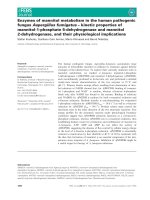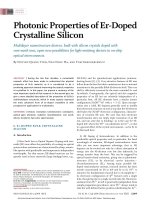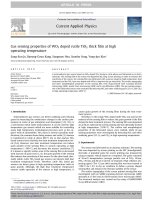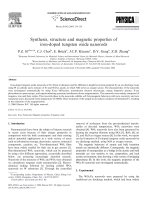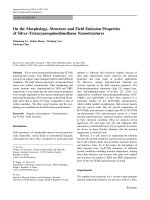Dosimetric properties of an environmental H*(10) dosemeter based on radiophotoluminescence of silver doped phosphate glass
Bạn đang xem bản rút gọn của tài liệu. Xem và tải ngay bản đầy đủ của tài liệu tại đây (725.55 KB, 5 trang )
Radiation Measurements 138 (2020) 106468
Contents lists available at ScienceDirect
Radiation Measurements
journal homepage: />
Dosimetric properties of an environmental H*(10) dosemeter based on
radiophotoluminescence of silver doped phosphate glass
Frank Assenmacher, Elisa Musto, Eduardo G. Yukihara *
Department of Radiation Safety and Security, Paul Scherrer Institute, Switzerland
A R T I C L E I N F O
A B S T R A C T
Keywords:
Radiophotoluminescence
RPL
Environmental dosimetry
H*(10)
IEC 62387
Type testing
The objective of this study was to investigate the energy and angle dependence of the RPL dosimetry system in
use at the Paul Scherrer Institute (GBFJ-01 dosimeter, FGD 660 reader, and CDEC-Easy algorithm) for the
operational dose quantity H*(10) and compare the results with the requirements from the Swiss dosimetry
regulation. The energy response was determined for photon energies between 12 keV (N-15) and 1250 keV
(60Co) and the angle response was determined for 65 keV (N-80) and 662 keV (137Cs). The data obtained in this
study show that the RPL dosimeters satisfy the requirements of the Swiss dosimetry regulation for the energy
dependence, but only partially satisfy the requirements for the angle dependence. For directional irradiations
around ±90◦ the dosimeter response can deviate by more than the 20% allowed by the Swiss dosimetry regu
lation. If a more realistic testing scenario for the 90◦ irradiation is used, which includes full rotation of the
dosimeter around its reference direction, the response is within 10% of the response at 0◦ irradiation. Full tests
according to the IEC 62387 were not performed and, therefore, performance against this standard cannot be fully
evaluated from this data. Nevertheless, the data indicate that the asymmetric dosimeter design would have
difficulties satisfying the IEC 62387 standard for H*(10) for low energy photons and large angle irradiation, in
spite of the allowance of full rotation for the 90◦ irradiations.
1. Introduction
The radiophotoluminescence (RPL) of silver-doped phosphate glass
(P4O10:Ag+), which is the UV-excited photoluminescence from color
centers (Ag0, and Ag2+) created in the glass by ionizing radiation, is now
used commercially for personal dosimetry (Kurobori et al., 2010;
Miyamoto et al., 2010, 2011; Yamamoto et al., 2011). These color
centers are stable under optical excitation and do not fade over time,
making the readout non-destructive. Annealing of the glass detectors (e.
g. 400 ◦ C for 1 h) restores the original silver dopant (Ag+) concentration,
allowing the material to be used again with the same response (Yama
moto et al., 2011).
The silver-doped phosphate glass is an integrating, passive solid-state
detector, which, combined with filters for ionizing radiation, a dose
calculation algorithm and automated readers, can be used for the
measurement of the personal dose equivalent quantities Hp(10) and
Hp(0.07), or of the environmental dose equivalent H*(10) (Burgkhardt
et al., 1990; Piesch and Burgkhardt, 1994; Juto, 2002; Ranogajec-Komor
et al., 2008). A modern RPL dosimetry system consisting of a dosimeter
badge containing a silver-phosphate glass and different filters, auto
mated reader and a dose calculation algorithm for personal and envi
ronmental dosimetry is now commercialized by CHIYODA TECHNOL
CORP.
In 2016 the Paul Scherrer Institute (PSI) adopted for individual
monitoring of its staff the RPL system consisting of the GBFJ-01 dose
meter badge version and FGD-660 reader (CHIYODA TECHNOL CORP.).
This system was first used in 2008 at the Institut de Radioprotection et de
Sûret´e Nucl´eaire (IRSN, France) in their routine dosimetry service
(Hocine et al., 2011; Hocine, 2012). The dosemeter badge has di
mensions 61.0 × 30.0 × 8.0 mm3 and contains a RPL glass detector of
dimensions 35.0 × 7.0 × 1.5 mm3 and filters made from aluminum,
copper, tin, and two kinds of plastic materials, forming five differently
filtered areas of the glass detector; for details, see Hocine et al. (2011).
The detector material FD-7 was produced by AGC TECHNO GLASS CO.,
LTD., Shizuoka, with a weight composition of 31.55% P, 51.16% O,
6.12% Al, 11% Na, and 0.17% Ag resulting in Ag+-doped phosphate
glass (P4O10: Ag+) (Yamamoto et al., 2011). The FGD-660 reader mea
sures each glass detector in five distinct positions, corresponding to the
* Corresponding author. Paul Scherrer Institute, Forschungsstrasse 111, 5232 Villigen PSI, Switzerland.
E-mail address: (E.G. Yukihara).
/>Received 12 May 2020; Received in revised form 14 August 2020; Accepted 16 September 2020
Available online 19 September 2020
1350-4487/© 2020 The Authors.
Published by Elsevier Ltd.
This is an open
( />
access
article
under
the
CC
BY-NC-ND
license
F. Assenmacher et al.
Radiation Measurements 138 (2020) 106468
five differently filtered areas in the dosemeter badge; see Huang and Hsu
(2011) for an illustration of the measurement principle. The dosimetric
properties of this system for Hp(10) and Hp(0.07) were reported by
Assenmacher et al. (2017) and demonstrated to satisfy the Swiss
dosimetry regulation for personal dosimeters.
The updated Swiss dosimetry regulation in effect since 2018 intro
duced requirements for environmental dosimeters to be used in
Switzerland (Swiss Federal Council, 2017). Requirements for H*(10) are
specified for the measurement range (from 0.05 mSv up to 100 mSv),
linearity (<15% in the 0.1 mSv–100 mSv dose region), energy depen
dence (<30% for energies between 50 keV and 5 MeV), angle depen
dence (<20% for energies > 50 keV), reproducibility (standard
deviation < 10%), and fading (<20% pro exposure period). Although
some of the dosimetric characteristics are not influenced by the quantity
of interest (e.g. reproducibility, fading and linearity), compliance
regarding the energy and angle dependence must be independently
checked for H*(10), because of the different conversion factors from air
kerma to the operational quantity, reference irradiation conditions, and
dose calculation algorithm in comparison with those for Hp(10).
The objective of this study was, therefore, to investigate the energy
and angle dependence of the RPL dosimetry system in use at PSI for the
operational dose quantity H*(10) and compare the results with the re
quirements from the Swiss dosimetry regulation. The results are also
interpreted in terms of the IEC 62387 standard (IEC, 2020), but in this
case the tests were not comprehensive. Because the entire system cali
bration and RPL readout is independent on the operational quantity
calculated, tests such as dose range, reproducibility, and dose linearity,
already determined for Hp(10) (Assenmacher et al., 2017), were not
repeated. The response of an H*(10) environmental type dosemeter to
beta radiation is not required to be verified according to the Swiss
dosimetry regulation or the IEC 62387 standard and, therefore, it was
not tested.
For positioning the dosemeters free in air, either Styrofoam™ (0.02
g/cm3) or card boards (sandwich type with a comb-like structure, 0.06
g/cm3) a few centimeter thick were used behind the dosemeters to
support them; backscattering from these materials can be considered
negligible. Because the dosemeter badge construction is sufficient to
establishing secondary particle equilibrium for H*(10), the so-called
“build-up plate” was not used. One experiment with Cs-137 irradia
tion with and without a 2 mm PMMA plate as build-up was performed to
confirm this assumption.
The irradiation conditions, photon energies, angles of incidence, and
reference doses used in this study, are summarized in Table 1 and
Table 2. For each condition typically 9–10 RPL dosemeters were irra
diated and measured, depending on the experiment. In a few cases the
number of dosemeters analyzed was reduced because of wrong irradi
ations. The energy response was determined for photon energies be
tween 12 keV (N-15) and 1250 keV (60Co) and the angle response was
determined for 65 keV (N-80) and 662 keV (137Cs).
When defining the irradiation angles and axes of rotation, the
dosimeter symmetry was considered (Fig. 1). The linear arrangement of
the filters A to E in the GBFJ-01 dosemeter badge and the corresponding
measurement areas in the glass detector defines a unique axis H
(resembling the horizontal dimension) of the dosemeter. The rotation
around the H-axis is symmetric in both directions, because the filters of
the badge surround the glass detector symmetrically.
Perpendicular to the H-axis and to the reference direction of the
dosemeter (pointing towards the radiation field or the source), a second
axis V (vertical dimension) can be defined for which the rotation around
the V-axis is not symmetric. When rotating around the V-axis the glass
detector elements distinguished by their filters move towards, respec
tively away from the radiation source due to the rotation. For a positive
rotation +αV the detector element E surrounded by a tin filter, moves
closer to the source.
Additionally, the measurement volume inside the detector, which is
determined by the laser beam adjustment and the detection optics inside
the FGD-660 reader, is closer to the front surface of the glass detector
slab in order to increase the sensitivity to low energy beta radiation with
low penetration depth in the detector material (Maki et al., 2016). Thus
front-side and back-side are expected to show a differing response. This
effect was tested with the 180◦ irradiation and for the asymmetric
rotation around the vertical axis only.
The Swiss dosimetry regulation specifies that the environmental
dosimeter must have an angle dependence <20% for energy >50 keV.
For most personal dosemeter designs, however, the 90◦ can be prob
lematic because of the asymmetric filter design (the radiation may avoid
the filter) or the detector positioning (one detector obstructing the field
of view of another detector), or both.
The IEC 62387, on the other hand, proposes that, for the angle of
2. Materials and methods
2.1. The RPL dosimetry system
The RPL dosimetry system investigated here is the same used by PSI’s
accredited personal dosimetry service and consists of the FD-7 RPL glass
(AGC TECHNO GLASS CO., LTD., Shizuoka), dosemeter badge type
GBFJ-01, reader type FGD-660, and dose calculation software CDECEasy (CHIYODA TECHNOL CORP., Tokyo) (Assenmacher et al., 2017).
The same procedures used at PSI for personal dosimetry were also
adopted for the environmental dosimetry, which include annealing of
the RPL glass detectors at 370 ◦ C for 10 min to reset the signal (the
complete cycle lasts about 2 h), and post-irradiation annealing at 100 ◦ C
for 1 h to establish a complete RPL signal build-up (Assenmacher et al.,
2017). The temperature of 370 ◦ C used at PSI was recommended by the
manufacturer and is slightly lower than the one mentioned in previous
publications (Yamamoto et al., 2011).
Table 1
ISO radiation qualities and mean gamma energies used at
angle α = 0◦ and reference dose H*(10) = 10.0 mSv for
determining the energy dependency of the dosemeter
response.
2.2. Irradiations
Photon irradiations according to the ISO norms 4037–1 (ISO, 1996)
and 4037–3 (ISO, 1999) were performed using 137Cs and 60Co sources
(OB20 irradiation device, Buchler GmbH, Braunschweig), or an ISO
VOLT Titan TI320 X-ray device (GE General Electric Inspection Tech
nologies) at PSI’s secondary standard dosimetry laboratory (SSDL). The
calibration is traceable to the primary standards of the
Physikalisch-Technische Bundesanstalt (PTB, Germany). The relative
uncertainties (coverage factor k = 2) of the irradiated dose values were
in the range from 3.4% to 3.9% for the OB20 device, and from 2.3% to
2.6% for the TI320, and include a 2% uncertainty of the conversion
factors from air kerma Ka to H*(10) (ISO, 1999). Typical
source-dosemeter distances were 2 m for the ISOVOLT TI320 device and
from 2 m to 6 m for the OB20 device.
2
Radiation Quality
Emean [keV]
N-15
N-25
N-40
N-60
N-80
N-100
N-120
N-150
N-200
N-250
N-300
137
Cs
60
Co
12
20
33
48
65
83
100
118
164
208
250
662
1250
F. Assenmacher et al.
Radiation Measurements 138 (2020) 106468
value for a 95.45% level of confidence (k = 2) from the t-distribution for
degrees of freedom ν, as in Table G.2 from the ISO/IEC Guide 99–3:2008
(ISO/IEC, 2008). The uncertainties uR in the responses R were calculated
by error propagation assuming an uncertainty of 3.9% (k = 2) for the
Cs-137 irradiations and 2.6% (k = 2) for the X-ray irradiations (see
Section 2.2). The uncertainties in the relative response r = R/R0 were
estimated simply as uR/R0, since R and R0 are correlated (an
over-estimation of the conventional true value will lead to an
over-estimation in both R and R0).
Table 2
ISO radiation qualities, irradiation angles and reference doses used for deter
mining the angular dependency of the dosemeter response.
Radiation
Quality
Rotation
axis
Angle α [◦ ]
H*(10) [mSv]
137
a
0, 180
− 120, − 105, − 90, − 75, − 60,
60, 75, 90, 105, 120
− 75, − 60, 60, 75, 90
90 rotated 8 × 45 around the
reference direction
10.0
Cs, N-80
V
H
V or Hb
8.0 (8 × 1.0) or
16.0 (8 × 2.0)
3. Results
a
Rotation direction V or H is not relevant here.
The axis is irrelevant, since the dosimeter is rotated 360◦ around the refer
ence direction of the dosemeter.
b
3.1. H*(10) response
The response of the RPL glasses in terms of H*(10) is presented in
Table 3. One irradiation was performed with a 2 mm PMMA as build-up
plate. Firstly, the results confirm that the PMMA does not have an in
fluence on the indicated value of the RPL dosimeters. Secondly, using
the routine calibration procedure for the RPL system, the CDEC-Easy
algorithm seems to over-estimate the H*(10) values by 4–6%.
This over-estimation is within the tolerance of the Swiss dosimetry
regulations (±10%). Nevertheless, we should point out that the same
calibration is used by the RPL system to calculate both Hp(10) and H*
(10) based on different algorithms. In the case of Hp(10) measurements
for RPL dosimeters irradiated on phantom, no over-estimation is
observed (Assenmacher et al., 2017). Therefore, the user must decide
whether or not to apply an additional correction to the RPL indicated
values for the H*(10).
3.2. Energy dependence
Fig. 2 shows the H*(10) relative response to photon radiation qual
ities with energy in the range from 12 keV to 1250 keV (ISO, 1999). Data
for the Hp(10) (Assenmacher et al., 2017) are also shown for
comparison.
The H*(10) relative response satisfies the Swiss dosimetry regulation
requirement for the energy dependence, <30% for H*(10) in the range
50 keV ≤ E ≤ 5000 keV, at least up to 1250 keV. Calibrated photon
radiation qualities at higher energies were not available at the time of
the tests. The data in Fig. 2 shows that the relative response is also within
the requirements between 0.71 and 1.67 of the IEC 62387.
Fig. 1. Geometry and axes of the detector/dosemeter badge.
incidence α = 90◦ the dosemeter shall be rotated around its reference
direction during exposure. If a continuous rotation during exposure is
not possible, the total dose shall be applied in eight identical fractions
from eight directions with an angle of 45◦ in between, thus covering a
full circle.
Therefore, in addition to the 90◦ irradiation, a “full rotation” irra
diation consisting of eight partial irradiations as proposed in the IEC
62387 was also performed.
3.3. Angle dependence
2.3. Dose calculation and analysis
Fig. 3 shows the H*(10) relative response to the N-80 radiation
quality for rotations around the H-axis (H-rotation) and the V-axis (Vrotation). Fig. 3 also indicates the requirements from the Swiss dosim
etry regulation (±20%) and the lower limit of the IEC 62387. The upper
limit of the IEC 62387 is outside the plotting range.
For rotations around the asymmetric V-axis (V-rotation), the influ
ence of the detector asymmetry is noticeable in the data. Furthermore,
The doses were calculated using the linear algorithm (Juto, 2002)
implemented in the CDEC-Easy software using the option for environ
mental dose calculation H*(10). Calibration of the dosimetry system is
based on dosemeters irradiated with 137Cs in the dose quantity air kerma
and is independent on the chosen calculation algorithm. Here the H*(10)
values provided by the algorithm are considered as the indicated value
of the system. The values include automatic corrections for reader
sensitivity and glass batch sensitivity. The signal due to background
radiation accumulated in the laboratory since pre-dose measurement
(after annealing) were automatically subtracted by CDEC-Easy. The
implementation details of the dose calculation algorithms are intellec
tual property of CHIYODA TECHNOL CORP. The reproducibility of the
dose measurements are typically <2% for doses above 0.5 mSv and for
Cs-137 irradiation (Assenmacher et al., 2017).
The energy and angle dependence are presented in terms of the
relative response, defined as R/R0, where R0 is the reference response, i.
e., the ratio between the indicated value provided by the dosimetry
system and the conventional true value of the quantity (IEC, 2020).
The uncertainty in the indicated value G were estimated by dividing
the standard deviation of the results by the square root of the sample size
(standard deviation of the mean), multiplied by the corresponding tp(ν)
Table 3
RPL indicated value and response irradiated using Cs-137 source at 0◦ . The
uncertainties are the combined uncertainties for a coverage factor k = 2.
H*(10)(a) [mSv]
n(b)
G(c) [mSv]
R(d)
10
10
10
5
5 (with PMMA)
6
10
10
3
3
10.47 ± 0.03
10.47 ± 0.11
10.40 ± 0.10
5.30 ± 0.02
5.30 ± 0.03
1.05 ±
1.05 ±
1.04 ±
1.06 ±
1.06 ±
(a)
0.04
0.04
0.04
0.04
0.04
conventional true value for the irradiation, having an uncertainty of 3.9%
(k = 2).
(b)
number of dosimeters irradiated.
(c)
indicated value for the irradiated dosimeters and combined uncertainty.
(d)
calculated response and combined uncertainty.
3
F. Assenmacher et al.
Radiation Measurements 138 (2020) 106468
The relative response for H-rotation is relatively symmetric, but also
shows a pronounced drop around 90◦ . The low penetration depth of N80 radiation with a mean photon energy of 65 keV leads to low RPL
signals for the metal filtered detection elements of the RPL glass de
tector. Even though the dosimeter construction is symmetric for rotation
around the horizontal axis and the filters cover the bottom and top side
of the glass detectors, the RPL measurement position within the glass is
shifted towards the front of the badge (Maki et al., 2016). Therefore, the
signals for angles 90◦ ± α are not expected to be the same. The relative
response to the irradiation angles of 105◦ and 120◦ were not tested for
the horizontal rotation, as we expected the non-symmetrical V-rotation
to be the most problematic.
If the full rotation proposed in the IEC 62387 is used for the 90◦
angle, the relative response is 0.93 ± 0.03. In this case, it is irrelevant if
the rotation is around the horizontal or vertical axis.
Fig. 4 shows the angle dependence results for 137Cs, also for rotations
around the H-axis (H-rotation) and V-axis (V-rotation). Again, the re
quirements from the Swiss dosimetry regulation and the lower limit of
the IEC 62387 are indicated in the figure.
The angular dependence of the response is much less pronounced for
137
Cs radiation field due to the deeper penetration depth of the 662 keV
photon radiation. Only for the V-rotation at +90◦ there is a drop of the
response below 0.8. Although 662 keV photons have a much higher
penetration depth, it is the build-up of absorbed energy which is much
lower at the surface than in deeper depth. This is due to the secondary
radiation transport processes after the absorption of a photon and
transfer of energy to the electrons of the detector material. This effect
could possibly be reduced if a build-up plate had been used for the Cs137 irradiation, but this is not a realistic situation during actual
deployment of the dosimeters in the field.
As in the case of N-80, the drop in response at ± 90◦ degree disap
pears when the full rotation proposed in the IEC 62387 is applied. For
the full rotation, the response is 0.90 ± 0.04.
Fig. 2. Relative response for the dose quantities H*(10) and Hp(10) as a
function of the average energy of the photon radiation field. See Table 1 for
reference conditions. Hp(10) data from (Assenmacher et al., 2017). The re
quirements of the Swiss dosimetry regulations are outside the margins of
the graph.
Fig. 3. RPL dosimeter H*(10) relative response as a function of angle of rota
tion around the H-axis (H-rotation) or around the V-axis (V-rotation) for radi
ation quality N-80. Due to symmetry considerations, the data for − 90◦ and
− 180◦ are the same as for +90◦ and +180◦ for the H-rotation (i.e. one mea
surement only for each angle), and the data for ±180◦ are the same for the Hrotation and for the V-rotation. “Full Rotation” means that the angle of inci
dence was 90◦ degrees, but the dosemeters were rotated around its reference
direction and irradiated in eight fractions (see Section 2.2). The upper limit of
the IEC 62387 is outside the plotting range.
for irradiations at close to 90◦ , the detected RPL signal changes rapidly
for a small angle change, since there is no filter covering the left and
right side of the glass detectors. Also the penetration depth in the
phosphate glass along the long axis leads to smaller RPL signals from the
detector elements further away from the source and shielded by the bulk
mass of the glass detector in between. As a result, for irradiation angles
around 90◦ the RPL detectors do not satisfy the Swiss dosimetry regu
lations, which requires the deviation between the measured and given
dose to be smaller than 20%.
Fig. 4. RPL dosimeter H*(10) relative response as a function of angle of rota
tion around the H-axis (H-rotation) or around the V-axis (V-rotation) for 137Cs.
Due to symmetry considerations, the data for − 90◦ and − 180◦ are the same as
for +90◦ and +180◦ for the H-rotation (i.e. one measurement only for each
angle), and the data for ±180◦ are the same for the H-rotation and for the Vrotation. “Full Rotation” means that the angle of incidence was 90◦ degrees, but
the dosemeters were rotated around the reference direction and irradiated in
eight fractions (see Section 2.2). The upper limit of the IEC 62387 is outside the
plotting range.
4
F. Assenmacher et al.
Radiation Measurements 138 (2020) 106468
4. Discussion and conclusions
Acknowledgements
The data obtained in this study show that the RPL dosimeters satisfy
the requirements of the Swiss dosimetry regulation for the energy
dependence, but only partially satisfy the requirements for the angle
dependence. For direction irradiations around ±90◦ the dosimeter’s
response can deviate by more than the 20% allowed by the Swiss
dosimetry regulation. This result is expected, given the asymmetric
badge design.
In practice, however, the natural background radiation is usually not
directional. Therefore, the full rotation scenario proposed by the IEC
62387 for the response at α = ±90◦ can be considered more realistic for
the natural background radiation. If the full rotation is used for the ±90◦
irradiation, the RPL response does not deviate from the unity by more
than 10%.
Moreover, the average photon energy of natural radiation back
ground is usually higher than 600 keV at ground level around the Paul
Scherrer Institute, and thus the deviation in response with incident angle
at N-80 is not as relevant for the response to the natural background
radiation.
Under the above considerations, the RPL dosimetry system consist
ing of the GBFJ-01 dosimeter, FGD 660 reader, and CDEC-Easy algo
rithm can be used for general environmental monitoring of natural
background radiation and area monitoring outside of buildings, if the
dosimetry system limitations are kept in mind. A direct comparison
between existing environmental and area monitoring (e.g. thermolu
minescence dosimeters) and the RPL dosemeters should provide further
support for the adoption of RPL for these applications. In cases where a
directed radiation field is to be monitored, irradiations with angles
around 90◦ should be avoided.
Full tests according to the IEC 62387 were not performed and,
therefore, performance against this standard cannot be fully evaluated
from this data. For example, the IEC 62387 requires the angle depen
dence for H*(10) to be evaluated with the three lowest energies in the
energy range, whereas here only the N-80 radiation quality was tested.
Nevertheless, the data indicates that the asymmetric dosimeter design
would have difficulties satisfying the IEC 62387 standard for H*(10) for
low energy photons and large angle irradiation.
This work was partially funded by the Swiss Federal Nuclear Safety
Inspectorate ENSI, contracts no. 100979 and CTR00491.
References
Assenmacher, F., Boschung, M., Hohmann, E., Mayer, S., 2017. Dosimetric properties of a
personal dosimetry system based on radiophotoluminescence of silver doped
phosphate glass. Radiat. Meas. 106, 235–241.
Burgkhardt, B., Piesch, E., Vilgis, M., Ishidoya, T., Ikegami, T., 1990. Modern automatic
readout systems for phosphate glass dosemeters using UV laser excitation. Radiat.
Protect. Dosim. 34, 369–372.
Hocine, N., Donadille, L., Huet, C., Iti´e, C., Clairand, I., 2011. Personal monitor glass
badge: theoretical dosimeter response calculated with the Monte Carlo transport
code MCNPX. Radiat. Protect. Dosim. 144, 231–233.
Huang, D.Y.C., Hsu, S.-M., 2011. Radio-photoluminescence glass dosimeter (RPLGD). In:
Gali-Muhtasib, H. (Ed.), Advances in Cancer Therapy. IntechOpen.
IEC, 2020. International Standard IEC 62387:2020-01: radiation protection
instrumentation – dosimetry systems with integrating passive detectors for
individual, workplace and environmental monitoring of photon and beta radiation.
International Electrotechnical Commission, Geneva.
ISO, 1996. International Standard ISO 4037-1: X and Gamma Reference Radiation for
Calibrating Dosemeters and Doserate Meters and for Determining Their Response as
a Function of Photon Energy - Part 1: Radiation Characteristics and Production
Methods. International Organization for Standardization, Geneva.
ISO, 1999. International Standard ISO 4037-3: X and Gamma Reference Radiation for
Calibrating Dosemeters and Doserate Meters and for Determining Their Response as
a Function of Photon Energy - Part 3: Calibration of Area and Personal Dosemeters
and the Measurement of Their Response as a Function of Energy and Angle of
Incidence. International Organization for Standardization, Geneva.
ISO/IEC, 2008. ISO/IEC Guide 98-3: Guide to the Expression of Uncertainty in
Measurement (GUM:1995). International Organization for Standardization, Geneva.
Juto, N., 2002. The large scale personal monitoring service using the latest personal
monitor glass badge. The First Asian and Oceanic Congress for Radiation Protection.
AOCRP.
Kurobori, T., Zheng, W., Miyamoto, Y., Nanto, H., Yamamoto, T., 2010. The role of silver
in the radiophotoluminescent properties in silver-activated phosphate glass and
sodium chloride crystal. Opt. Mater. 32, 1231–1236.
Maki, D., Ube, M., Nagashima, Y., Shinozaki, W., Ueno, S., Koguchi, Y., Takeuchi, R.,
2016. Development of the new glass badge. Radiat. Protect. Dosim. 171, 337–345.
Miyamoto, Y., Yamamoto, T., Kinoshita, K., Koyama, S., Takei, Y., Nanto, H.,
Shimotsuma, Y., Sakakura, M., Miura, K., Hirao, K., 2010. Emission mechanism of
radiophotoluminescence in Ag-doped phosphate glass. Radiat. Meas. 45, 546–549.
Miyamoto, Y., Takei, Y., Nanto, H., Kurobori, T., Konnai, A., Yanagida, T., Yoshikawa, A.,
Shimotsuma, Y., Sakakura, M., Miura, K., Hirao, K., Nagashima, Y., Yamamoto, T.,
2011. Radiophotoluminescence from silver-doped phosphate glass. Radiat. Meas. 46,
1480–1483.
Piesch, E., Burgkhardt, B., 1994. Photoluminescence dosimetry: the alternative in
personnel dosimetry. Radioprotection 29, 39–67.
Ranogajec-Komor, M., Knezevic, Z., Miljanic, S., Vekic, B., 2008. Characterisation of
radiophotoluminescent dosimeters for environmental monitoring. Radiat. Meas. 43,
392–396.
Swiss Federal Council, 2017. Verordnung des EDI über die Personen- und
Umgebungsdosimetrie (Dosimetrieverordnung).
Yamamoto, T., Maki, D., Sato, F., Miyamoto, Y., Nanto, H., Iida, T., 2011. The recent
investigations of radiophotoluminescence and its application. Radiat. Meas. 46,
1554–1559.
Declaration of competing interest
The authors declare that they have no known competing financial
interests or personal relationships that could have appeared to influence
the work reported in this paper.
5

